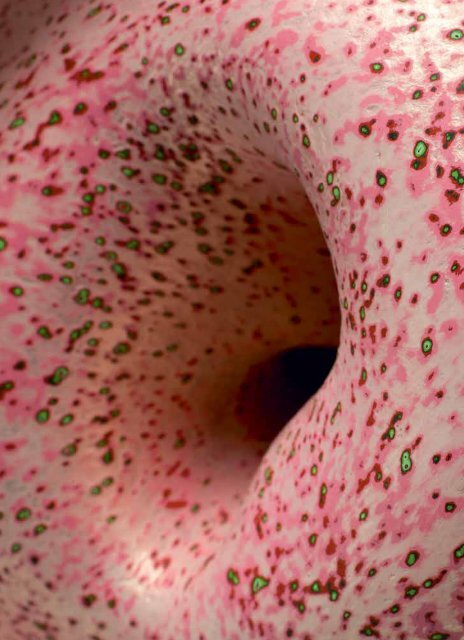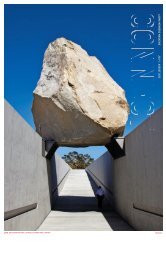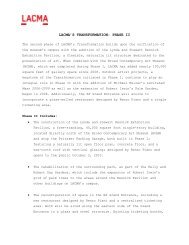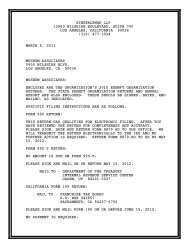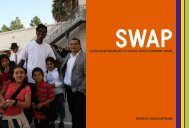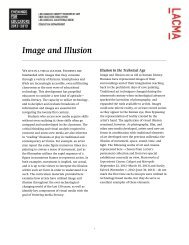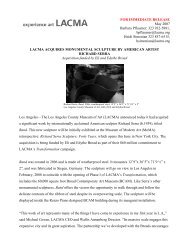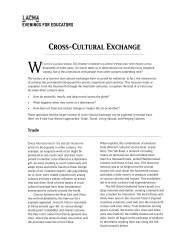Reflections on Ken Price - Los Angeles County Museum of Art
Reflections on Ken Price - Los Angeles County Museum of Art
Reflections on Ken Price - Los Angeles County Museum of Art
Create successful ePaper yourself
Turn your PDF publications into a flip-book with our unique Google optimized e-Paper software.
KEN PRICE<br />
Remembered<br />
After a prol<strong>on</strong>ged illness, sculptor <strong>Ken</strong> <strong>Price</strong> passed<br />
away in February 2012 at the age <strong>of</strong> seventy-seven.<br />
Although he did not live to see his retrospective,<br />
<strong>Price</strong> was involved in planning the show and the<br />
publicati<strong>on</strong> with us until two weeks before his<br />
death. He had approved the installati<strong>on</strong> design,<br />
read every word <strong>of</strong> the catalogue, made<br />
suggesti<strong>on</strong>s about the nature <strong>of</strong> the illustrati<strong>on</strong>s,<br />
given us notes <strong>on</strong> the height <strong>of</strong> each sculpture we<br />
displayed, and even how he would like the works<br />
illuminated. On September 12, prior to the opening<br />
<strong>of</strong> <strong>Ken</strong> <strong>Price</strong> Sculpture: A Retrospective, LACMA<br />
organized a celebrati<strong>on</strong> <strong>of</strong> his life with remembrances<br />
by close friends and artists, including<br />
T<strong>on</strong>y Berlant, Vija Celmins, Frank Gehry, R<strong>on</strong> Nagle,<br />
and Ed Ruscha. We have invited several additi<strong>on</strong>al<br />
artists to share their thoughts and memories <strong>of</strong><br />
<strong>Price</strong>. The comments here reveal the deep impact<br />
<strong>Price</strong> and his work had up<strong>on</strong> the art community.<br />
John Mas<strong>on</strong> and <strong>Price</strong> studied together under Peter<br />
Voulkos at the <strong>Los</strong> <strong>Angeles</strong> <strong>County</strong> <strong>Art</strong> Institute<br />
(later renamed Otis College <strong>of</strong> <strong>Art</strong> and Design) from<br />
1956 through 1957. <strong>Ken</strong> <strong>Price</strong> shared a Venice studio<br />
with Billy Al Bengst<strong>on</strong> from 1960 to 1962, and they,<br />
together with Larry Bell, Robert Irwin, and Ed<br />
Moses, all became friends through the Ferus<br />
Gallery. T<strong>on</strong>y Berlant’s friendship with <strong>Price</strong> began<br />
when he saw <strong>on</strong>e <strong>of</strong> <strong>Price</strong>’s exhibiti<strong>on</strong>s at the Ferus<br />
Gallery while Berlant was still in high school. In<br />
the 1970s, <strong>Price</strong> purchased a timeshare with Bell in<br />
Taos, New Mexico, where he met, am<strong>on</strong>g other<br />
artists who spent c<strong>on</strong>siderable time in the area,<br />
Lynda Benglis and Doug Wheeler, who had also<br />
become an admirer <strong>of</strong> <strong>Price</strong>’s work after seeing his<br />
exhibiti<strong>on</strong>s at LACMA and the Mizuno Gallery. <strong>Price</strong><br />
taught at the University <strong>of</strong> Southern California from<br />
1991 to 2001, during which time he met Shar<strong>on</strong><br />
Lockhart, who had joined the faculty in 2000.<br />
Stephanie Barr<strong>on</strong>, Senior Curator, Modern <strong>Art</strong>, LACMA<br />
OPPOSITE: <strong>Ken</strong> <strong>Price</strong>, Balls C<strong>on</strong>go (detail),<br />
2003, fired and painted clay, collecti<strong>on</strong> <strong>of</strong><br />
Linda Schlenger, © <strong>Ken</strong> <strong>Price</strong>, photo<br />
© Fredrik Nilsen<br />
I first met <strong>Ken</strong> around 1958. I was a student <strong>of</strong> Robert Irwin at<br />
Chouinard. Bob was a friend <strong>of</strong> <strong>Ken</strong>ny’s and introduced me to<br />
him at Barney’s Beanery, where they used to go. Coincidently,<br />
I had a job at a little c<strong>of</strong>fee house <strong>on</strong> Sunset very near, and I<br />
would go to Barney’s after work. I met a lot <strong>of</strong> artists there—<br />
from Alto<strong>on</strong> to Kienholz. I got to know Billy Al Bengst<strong>on</strong>, and<br />
<strong>Ken</strong>ny was his closest pal; they shared a studio together the<br />
next year in Ocean Park. I took a studio the next street south,<br />
and Alto<strong>on</strong> moved in next door.<br />
<strong>Ken</strong> had a studio in a small strip <strong>of</strong> stores <strong>on</strong> Roberts<strong>on</strong>. One<br />
night burglars pried open <strong>Ken</strong>ny’s back door and entered with<br />
plans to punch a hole in the wall that adjoined an appliance<br />
store. They chose an area where <strong>Ken</strong> kept his greenware to<br />
dry. When <strong>Ken</strong> discovered the destroyed wall, he called me<br />
and I was right there. <strong>Ken</strong> was picking up demolished plaster<br />
and wood when I came in, and I was shocked by the scope <strong>of</strong><br />
the damage to the room. I asked how much work he lost. He<br />
pointed to the other side <strong>of</strong> the room, “Nothing! Nothing was<br />
damaged. They moved everything; the <strong>on</strong>ly thing they took<br />
from my studio was that photo you gave me.” These were<br />
pretty sensitive burglars.<br />
<strong>Ken</strong> was probably the most unique sculptor <strong>of</strong> the times. From<br />
my perspective, he was a giant in my life and the pers<strong>on</strong>ificati<strong>on</strong><br />
<strong>of</strong> a serious artist with an incredible sense <strong>of</strong> humor. <strong>Ken</strong><br />
moved to New Mexico around 1970, and I followed him in 1972.<br />
I moved to New Mexico because he moved there. I ended up<br />
in the house that he had originally bought, and I lived there<br />
for thirty years. When we were younger, we hung pretty close<br />
together with a few other bros. When <strong>Ken</strong>’s family grew,<br />
I tried not to be in his face, although I know he loved the<br />
company <strong>of</strong> his pals. Knowing that <strong>Ken</strong> was at work was all<br />
I needed to nourish my strength in the studio.<br />
<strong>Ken</strong>ny’s awesome skill and totally “<strong>of</strong>f the wall” sense <strong>of</strong><br />
humor will live with me all my days, and I feel totally blessed<br />
to have known him. LARRY BELL
I first met <strong>Ken</strong> through his work when I saw his<br />
show at Ferus Gallery, while I was still in high<br />
school. Each stood powerful—with plenty <strong>of</strong> room<br />
To quote my mother:<br />
“<strong>Ken</strong> was as sharp as a razor<br />
and as gentle as a dove.”<br />
<strong>Ken</strong> was always a dedicated and focused artist,<br />
but never lost the humor in life.<br />
A l<strong>on</strong>ger life has some rewards—<br />
<strong>on</strong>e thing that is not <strong>on</strong>e <strong>of</strong> them<br />
is writing about friends that have passed.<br />
<strong>Ken</strong> truly was a gem.<br />
He was clear,<br />
He was sharp,<br />
He was amused.<br />
True, we can speak <strong>of</strong> him as a rare gift<br />
and a rare and brilliant artist.<br />
Without metaphor—<br />
Without metaphor— JOHN MASON<br />
I envied his studio, his music, his studio habits,<br />
his complete immersi<strong>on</strong>, and his passi<strong>on</strong> for his<br />
work. <strong>Ken</strong>ny <strong>Price</strong> was the first and still the best<br />
c<strong>on</strong>temporary sculptor to employ the full power <strong>of</strong><br />
color: its physicality, its weight, density, and<br />
unique ability to articulate form and feelings.<br />
Looking at <strong>Ken</strong>ny’s work, you were always touched<br />
by the color and the unique feeling that if you<br />
were to break <strong>on</strong>e <strong>of</strong> his works in half, it would be<br />
the same intense color all the way through. <strong>Ken</strong>ny<br />
When I was a young man going to Chouinard,<br />
I felt lost—certain that I was an artist, yet<br />
unsure about the meaning <strong>of</strong> the work I was<br />
making. The big questi<strong>on</strong> that plagued me<br />
and seemed to doom my every effort was<br />
“YEAH, SO WHAT?” All these years later, these<br />
doubts seem overly fraught and kind <strong>of</strong><br />
ridiculous, but at the time, I felt I was in the<br />
fight <strong>of</strong> my life to find my way.<br />
I remember vividly when I first encountered<br />
<strong>Ken</strong>ny <strong>Price</strong>’s works, those magical little<br />
cups at my friend Riko Mizuno’s gallery.<br />
A beautiful installati<strong>on</strong> that itself became a<br />
critical part <strong>of</strong> the experience—completely<br />
c<strong>on</strong>fident and unassuming, it took me from<br />
the micro to the macro and back. And when<br />
I saw his show that he shared with Bob Irwin<br />
at the L.A. <strong>County</strong>, it truly changed me.<br />
Here was a guy, who really dug what he did.<br />
There seemed to be a joy and playfulness<br />
that lived with a deadly seriousness. The<br />
sculptures I saw in that show stopped me,<br />
slowed me down, and I looked, really looked<br />
at the beautiful complexity <strong>of</strong> color and<br />
texture and shape, shapes within shapes <strong>of</strong><br />
these serious yet whimsical sculptures. It was<br />
a transformati<strong>on</strong>al experience for me, and<br />
<strong>on</strong>e that gave me the c<strong>on</strong>fidence to keep<br />
pursuing my course and permissi<strong>on</strong> to find<br />
some joy in the making.<br />
for their individuality to shine. I noticed<br />
a small cactus that looked like a split pebble in<br />
the gallery window and asked Irving why it was<br />
there and he said that <strong>Ken</strong> had told him to point it<br />
out if any<strong>on</strong>e asked him to explain the work.<br />
<strong>Ken</strong>’s work, in fact, remained objects <strong>of</strong> nature—<br />
his nature. It was always comforting to hear him<br />
say “I <strong>on</strong>ly provide the labor.” A shamanistic<br />
mantra—a c<strong>on</strong>victi<strong>on</strong> that a w<strong>on</strong>derful thing<br />
would come out <strong>of</strong> us if we surrendered to our<br />
impulses and gave all we had to give in following<br />
them. When I saw <strong>Ken</strong>’s work I thought <strong>of</strong> him.<br />
When I saw <strong>Ken</strong> I thought <strong>of</strong> his work. Now he is a<br />
radiant laughing presence, in his work and in my<br />
memory. TONY BERLANT<br />
<strong>Ken</strong> is the artist <strong>of</strong> many forms—a draftsman,<br />
a craftsman, an abstracti<strong>on</strong>ist <strong>of</strong> primary<br />
<strong>Price</strong> was an artist to whom I owe a great debt . . .<br />
and I love him for it. ROBERT IRWIN<br />
ABOVE: <strong>Ken</strong> <strong>Price</strong>, L. Red, 1963, ceramic painted<br />
with lacquer and acrylic <strong>on</strong> wood base, San<br />
Francisco <strong>Museum</strong> <strong>of</strong> Modern <strong>Art</strong>, Evelyn and<br />
Walter Hass Jr. Fund Purchase, 82.155, © <strong>Ken</strong> <strong>Price</strong>,<br />
photo © Fredrik Nilsen<br />
LEFT: <strong>Ken</strong> <strong>Price</strong>, Snail Cup, 1967, glazed ceramic,<br />
collecti<strong>on</strong> <strong>of</strong> Vija Celmins, © <strong>Ken</strong> <strong>Price</strong>, photo<br />
© Fredrik Nilsen<br />
I feel lucky I was able to finally get to know<br />
<strong>Ken</strong>ny in the years since. He was an incredibly<br />
generous artist and a true friend to the<br />
many who loved him. The world he created<br />
with his work and his beautiful family was<br />
a c<strong>on</strong>tinuing touchst<strong>on</strong>e about the best<br />
way to live and work, something for which<br />
I will always be grateful. DOUG WHEELER<br />
form who always took color and surface into<br />
c<strong>on</strong>siderate detail. Those primary organic<br />
forms have universal meaning with emotive<br />
c<strong>on</strong>tent and energy. I shall miss his presence<br />
and <strong>on</strong>going c<strong>on</strong>versati<strong>on</strong>. LYNDA BENGLIS<br />
OPPOSITE: <strong>Price</strong> in Japan, 1962, courtesy the <strong>Ken</strong><br />
<strong>Price</strong> archives
I first met <strong>Ken</strong> <strong>Price</strong> in 2000, when<br />
I was hired to teach at USC. In fact,<br />
he was <strong>on</strong>e <strong>of</strong> the reas<strong>on</strong>s I took the job.<br />
I was h<strong>on</strong>ored to be in his presence and<br />
to sit in meetings with him. We talked<br />
a lot about his house and studio in<br />
New Mexico, which he was building<br />
together with his wife, Happy. It was<br />
his dream, and it was so inspiring to<br />
watch it come true for him.<br />
For years, I thought <strong>of</strong> asking <strong>Ken</strong><br />
if I could make a portrait <strong>of</strong> him in an<br />
open studio class am<strong>on</strong>g a handful <strong>of</strong> his<br />
students. He moved to New Mexico to<br />
live his dream before I got up the<br />
courage to ask to make the photograph.<br />
Years passed, and each week I would<br />
walk by the double-decker industrial<br />
lockers in the hallway outside <strong>of</strong> the<br />
ceramics studio where <strong>Ken</strong> had kept his<br />
tools and supplies. Left <strong>on</strong> them was big<br />
black vinyl lettering that spelled out<br />
“PRICE” <strong>on</strong> each <strong>of</strong> the four lockers’<br />
doors. I always felt his presence when<br />
I walked by them. He was a kind,<br />
laid-back man who was eternally<br />
inspired. SHARON LOCKHART<br />
RIGHT: <strong>Ken</strong> <strong>Price</strong>, Arctic (detail), 1998,<br />
fired and painted clay, The <strong>Museum</strong> <strong>of</strong><br />
Modern <strong>Art</strong>, New York, gift <strong>of</strong> Edward R.<br />
Broida, 757.2005, © <strong>Ken</strong> <strong>Price</strong>, photo<br />
© Fredrik Nilsen<br />
OPPOSITE TOP: <strong>Ken</strong> <strong>Price</strong>, Zizi, 2011, fired<br />
and painted clay, LACMA, purchased with<br />
funds provided by the Modern and<br />
C<strong>on</strong>temporary <strong>Art</strong> Acquisiti<strong>on</strong> Fund and<br />
gift <strong>of</strong> Matthew Marks, © <strong>Ken</strong> <strong>Price</strong>,<br />
photo © Fredrik Nilsen<br />
OPPOSITE BOTTOM: <strong>Price</strong> signing earthenware<br />
cups at Gemini G.E.L., February<br />
1992, photo © 1992 Sidney B. Felsen<br />
I FIRST MET KEN IN JULY OF 1953. MY CAMP-SIDE PAD,<br />
DOHENY BEACH STATE PARK. HE WAS ON A SURFING<br />
SAFARI WITH THE MALIBU TRIBE. FROM 1953 UNTIL<br />
1966, WE WERE AS CLOSE AS BOYS GET ART-WISE AND<br />
FUN-WISE. KEN WAS PROBABLY THE BRAVEST AND<br />
MOST DEDICATED STUDIO RAT IN THE WORLD OF ART.<br />
HE TOOK FARTHY DE OUT TO FARTHY DE IN.<br />
IN OTHER WORDS,<br />
MOVE IN SUCKER AND TAKE A CLOSE LOOK. BILLY AL BENGSTON<br />
<strong>Ken</strong>ny and I used to talk about fishing a lot—we had a fantasy that we<br />
shared <strong>of</strong> going fishing together, though neither <strong>of</strong> us was much <strong>of</strong> a<br />
fisherman. Anyway, we decided to do it. We got all <strong>of</strong> this gear, and we<br />
hiked and hiked, and the gear was getting heavier and heavier. We<br />
hiked up to the edge <strong>of</strong> this precipice that overlooked a lake and<br />
started to go to the edge <strong>of</strong> this path that curved around. All <strong>of</strong> the<br />
sudden both <strong>of</strong> us heard a rustle in the bushes, and then a brown bear<br />
came out and was sort <strong>of</strong> pushing his snout around. Anyway, he took<br />
<strong>of</strong>f after <strong>Ken</strong>ny, and so<strong>on</strong> both the bear and <strong>Ken</strong>ny fell <strong>of</strong>f the edge <strong>of</strong><br />
the precipice. The bear landed <strong>on</strong> a ledge and was dazed. But <strong>Ken</strong>ny<br />
kept falling. After about fifty feet or so, <strong>Ken</strong>ny came out into this<br />
perfect dive and pierced the water in the lake. I had taken <strong>of</strong>f running<br />
after him down the hill, and I had to stop to take a look down, and<br />
there was <strong>Ken</strong>ny at the bottom, sitting buck naked with two trout<br />
strung up. He already had a fire going. I had made us a purchase <strong>of</strong><br />
hand bobs and fishing gear, and his line was bobbing away.<br />
He was an amazing pers<strong>on</strong>. He was a driven, poetic man. He had a<br />
chance to be a trumpet player, but he approached Chet Baker and Chet<br />
Baker told him to be an artist. <strong>Ken</strong>ny also had a tremendous record<br />
collecti<strong>on</strong>. <strong>Ken</strong>ny could listen to records all<br />
day—Happy said you could slip a plate <strong>of</strong> food<br />
under the door and he’d be fine.<br />
There’s nothing more to say. He is total magic.<br />
He’s a magnificent perpetrator <strong>of</strong> these forms.<br />
He is pure heart and impeccable character.<br />
ED MOSES
COVER: <strong>Ken</strong> <strong>Price</strong>, Cheeks (detail), 1998, fired and painted clay, collecti<strong>on</strong> <strong>of</strong> Romy Col<strong>on</strong>ius, © <strong>Ken</strong> <strong>Price</strong>, photo © Fredrik Nilsen


